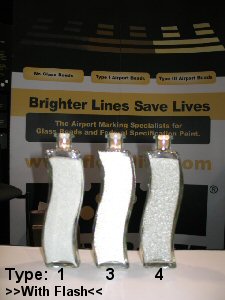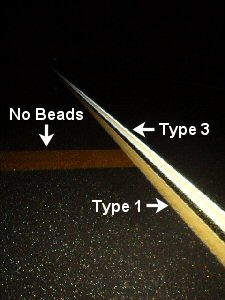
|

|
|
Sightline Youth in Search of the TruthBy Mike SpeidelHello and congratulations on finding my piece of the Sightline webletter. If you and I have never met before, let me be the first to introduce myself. My name is Mike Speidel, Sightline's Marketing Manager and Contributing Editor. I am young, witty, and my headlines rhyme: I'm a triple-threat. My mission is to discuss industry issues in a way that is easy to understand, so that you can then impress others with your newly acquired knowledge. You don't have to thank me now, but if I don't hear from you eventually, I will find you. Today I am in Search of the Truth about Glass Beads - how they work, distinctions among bead types, and proper application procedures for ideal results. To preface, glass beads are utilized in the industry to produce reflectivity in airport markings. Beads are dropped on markings immediately after material is applied to the runway surface, and make the markings reflective and hopefully bright at night.
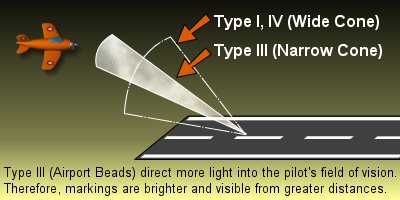 It just wouldn't be a Sightline article without mentioning Surface Preparation! Many common material failures can be avoided by prepping the surface before applying material. If you are going to invest the money into a safer project, do it right the first time. Once the surface is clean, dry, and ready for application; here are the basics. When applying Type I and Type III beads, the material (we use water-borne paint) should be applied consistently at 15 mils WET. How do you measure wet film thickness? Use a wet film thickness gauge, pictured below. If you send us a nice email with your mailing address, we will be happy to send you one free! Beads are dropped directly onto the wet marking with a beader, preferably mounted right behind the paint gun. For Type I beads, the application rate is seven pounds of beads for every one gallon of paint. For Type III beads, the application rate is twelve pounds of beads for every one gallon of paint. If you would like a kit to measure bead application rates, email us and we'll hook you up with that for free too! The idea is to have the beads halfway submerged in the marking, illustrated below. If the paint is too thick the beads will sink too deep into the material. If the paint is too thin the beads will sit up too high and not bond well with the material. In both cases, reflectivity will be severely diminished. 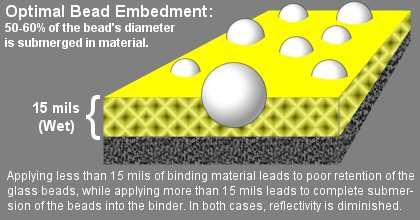 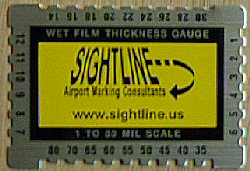 I have not said much about the Type IV beads due to the fact that we have not yet had enough field data to draw conclusions about them. Common sense tells us that a larger bead would require more than 15 mils of paint to reach optimal embedment. We will inform you about our official stance regarding Type IV when we know! For more information, or our Marking Matters Training, it's all available to you at Sightline. If your markings could benefit from better materials and professional help, just know that Sightline is your diamond (or airport bead) in the rough.
"All truths are easy to understand once they are discovered; the point is to discover them."
-Galileo Galilei
|

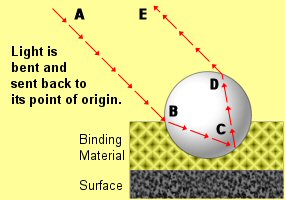 So how do they work? If you're like me, you slept through your Physics lecture
because you were up late the night before tutoring co-eds (I cannot divulge which subject).
However, from what I have read, light travels faster through the air than it does through the
glass spheres. The illustration to the right shows light approaching a glass bead (A). When the
light travels through the denser glass, it slows down and bends (B). The angle by which it bends
is called the angle of refraction. The light then reflects at the back of the bead (C),
inheriting the color of the material it is embedded in, and then travels through the front of the
bead (D), back to its point of origin (E).
So how do they work? If you're like me, you slept through your Physics lecture
because you were up late the night before tutoring co-eds (I cannot divulge which subject).
However, from what I have read, light travels faster through the air than it does through the
glass spheres. The illustration to the right shows light approaching a glass bead (A). When the
light travels through the denser glass, it slows down and bends (B). The angle by which it bends
is called the angle of refraction. The light then reflects at the back of the bead (C),
inheriting the color of the material it is embedded in, and then travels through the front of the
bead (D), back to its point of origin (E).
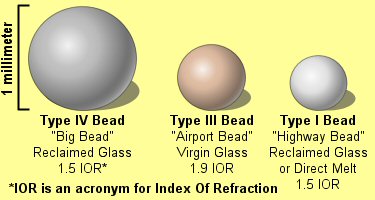 So why do Type III beads produce much brighter readings when tested? Type I and
IV beads are comprised of reclaimed glass and were originally developed for highway use. Type III
beads are made with virgin glass, the highest quality, and specifically designed for the higher
speeds encountered on runways. Further, the focal point in Type III beads is smaller than that of
either Type I or IV, which means that more light is returning to the point of origin. Think of a
flashlight with a rotating lens that you can turn to focus the beam of light. The narrower the
beam, the more the light is concentrated in one spot, allowing you to see things further away.
The same is true for a plane's lights being reflected by Airport beads. Shown below, the Type III
beads (1.9 IOR) reflect the light back to the pilot in a narrow cone, while Type I and IV (1.5 IOR)
reflect the light in a wider cone. The pilot sees more light due to the airport beads, and therefore
the markings are brighter and can be seen from further away. That is, if they were installed
properly at application!
So why do Type III beads produce much brighter readings when tested? Type I and
IV beads are comprised of reclaimed glass and were originally developed for highway use. Type III
beads are made with virgin glass, the highest quality, and specifically designed for the higher
speeds encountered on runways. Further, the focal point in Type III beads is smaller than that of
either Type I or IV, which means that more light is returning to the point of origin. Think of a
flashlight with a rotating lens that you can turn to focus the beam of light. The narrower the
beam, the more the light is concentrated in one spot, allowing you to see things further away.
The same is true for a plane's lights being reflected by Airport beads. Shown below, the Type III
beads (1.9 IOR) reflect the light back to the pilot in a narrow cone, while Type I and IV (1.5 IOR)
reflect the light in a wider cone. The pilot sees more light due to the airport beads, and therefore
the markings are brighter and can be seen from further away. That is, if they were installed
properly at application!

